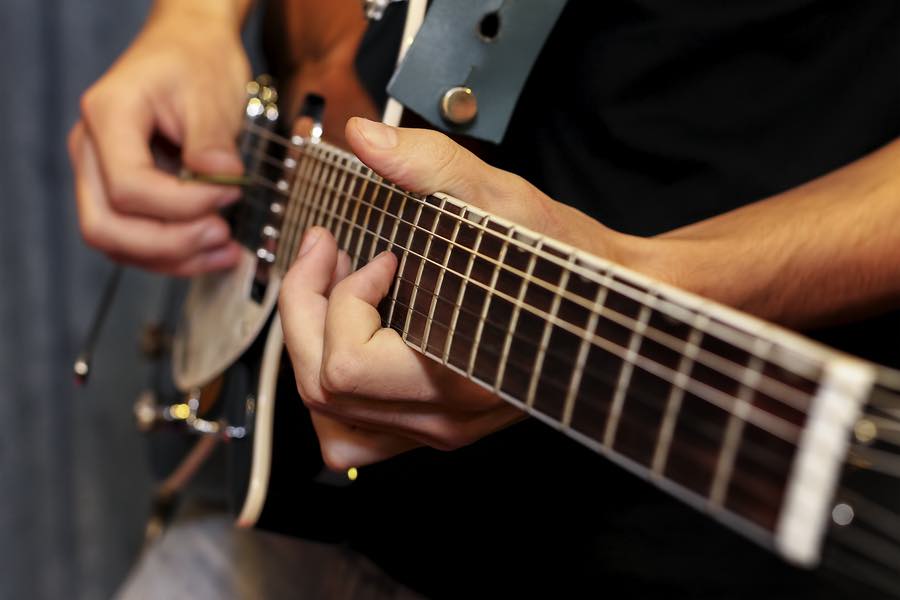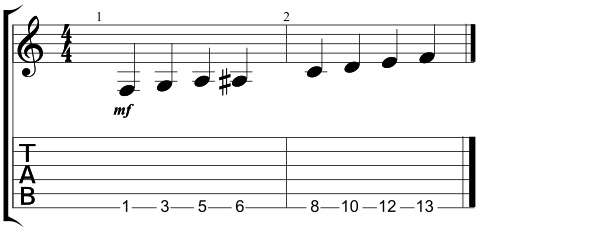May 14, 2019 by Klaus Crow
Bigstock photo
 Knowing how to build a scale is essential for understanding music theory, learning how the guitar works, to able to communicate with other musicians and to grow towards becoming an accomplished guitar player.
Knowing how to build a scale is essential for understanding music theory, learning how the guitar works, to able to communicate with other musicians and to grow towards becoming an accomplished guitar player.
Every piece of musical knowledge adds to your musicianship and makes you become a better guitar player. Applied knowledge is power.
The whole-half Step formula is the perfect way to build and recognize the pattern of any scale. The scales you need for soloing, chord construction, chord progressions, arpeggios and a dozen of other things. It gives you insight in the whole matter.
So let’s see how this baby works.
The whole-half step formula is similar to the scale formulas only it uses whole and half steps to explain the construction of a scale.
A half step = one fret. A whole step = two frets. So going one fret up or down the neck is a half step. Going up or down two frets equals a whole step.
Let’s take the major scale as an example:
Major scale = Whole step – Whole step – Half step – Whole step – Whole step – Whole step – Half step
or simplified: W-W-H-W-W-W-H (W = Whole, H = Half)
You can also notate the fret intervals: 2-2-1-2-2-2-1 (W = 2, H = 1)
HORIZONTAL APPROACH
Let say you want to create an F major scale. The Formula = W-W-H-W-W-W-H.
So you start on the 1st fret, low E-string (6th string). The first note is an F note. Then you move up a whole step (2 frets), that note is a G note. You move up another whole up (2 frets), that note is an A note. Then you move up a half step (1 fret), that note is a Bb. You move up a whole step, that note is a C note, another whole step and you’re on D, again a whole step, you’re on E and finally a half step and you’re back on an F note.
So F major scale = F G A Bb C D E F
F major scale in whole and half steps:
F major scale in Tab:
You can use the formula for any key.
THE FORMULAS
Here’s a list of whole-half step scale formulas:
W = Whole step, H = Half step, WH = Whole and a half step (3 half steps or frets).
Major scale = W-W-H-W-W-W-H (2-2-1-2-2-2-1)
Natuaral Minor scale = W-H-W-W-H-W-W (2-1-2-2-1-2-2)
Minor pentatonic scale = WH-W-W-WH-W (3-2-2-3-2)
Blues scale = WH-W-H-H-WH-W (3-2-1-1-3-2)
Major pentatonic scale = W-W-WH-W-WH (2 2 3 2 3)
Harmonic Minor scale = W-H-W-W-H-WH-H (2-1-2-2-1-3-2)
Melodic Minor scale = W-H-W-W-W-W-H (2-1-2-2-2-2-1)
Ionian scale = W-W-H-W-W-W-H (2-2-1-2-2-2-1)
Dorian scale = W-H-W-W-W-H-W (2-1-2-2-2-1-2)
Phrygian scale = H-W-W-W-H-W-W (1,2,2,2,1,2,2)
Lydian scale = W-W-W-H-W-W-H (2,2,2,1,2,2,1)
Mixolydian scale = W-W-H-W-W-H-W (2,2,1,2,2,1,2)
Aeolian scale = W-H-W-W-H-W-W (2-1-2-2-1-2-2)
Locrian scale = H-W-W-H-W-W-W (1,2,2,1,2,2,2)
Whole tone scale = W-W-W-W-W-W (2-2-2-2-2-2)
Whole-Half Diminished = W-H-W-H-W-H-W-H (2-1-2-1-2-1-2-1)
Half-Whole Diminished = H-W-H-W-H-W-H-W (1-2-1-2-1-2-1-2)
VERTICAL APPROACH
In order to play a scale vertically across multiple strings instead of horizontally on a single string you need to know how to play a whole step interval from one string to the next.
To move up a whole step from the low E-string (6th string) to the A-string (5th string) choose a starting point, then move up one string higher and then move down 3 frets (See diagram below).
A whole step from the A-string to the D-string: Move up one string higher and move down 3 frets.
A whole step from the D-string to the G-string: Move up one string higher and move down 3 frets.
A whole step from the G-string to the B-string: Move up one string higher and move down 2 frets.
A whole step from the B-string to the high E-string: Move up one string higher and move down 3 frets.
Let’s take the G major scale for example:
Major scale = W-W-H-W-W-W-H (2-2-1-2-2-2-1)
Building G Major scale using whole and half steps = G-W-A-W-B-H-C-W-D-W-E-W-F#-H-G
G major scale = G A B C D E F# G
In the diagram below you can see the whole steps from one string to the next that occur in the G major scale. I left out any other notes of the G major scale for the sake of visibility.
You can see a whole step from A to B, moving up one string and down 3 half steps (3 frets). A whole step from D to E, up one string down 3 half steps, A whole step from G to A, up one string down 3 half steps, A whole step from C to D, up one string down 2 half steps, A whole step from E to F#, up one string down 3 half steps.
All the notes of the G major scale with whole and half steps:
ASSIGNMENTS:
1 – Write down the notes for a C major scale using the whole half step formula.
2 – Play an C major scale, horizontal approach (on a single string) on the guitar.
3 – Write down and play a C major scale, vertical approach (played across multiple strings)
4 – Build a pentatonic minor scale on a single string.
5 – Memorize the whole-half step formulas for the major and natural minor scale.
6 – Play a vertical A major scale on the spot using your memorized major scale formula.
7 – Play a vertical E natural minor scale on the spot using your memorized minor scale formula.
8 – Create a short melody on the spot using the E minor scale from assignment 6.
Remember: Applied knowledge is power!




Thanks so much for this detailed lesson/informational piece. I love homework!
Sure thing Sue.
And I love to give homework :)
Best regards,
Klaus Crow
Hello Klaus,
Thank you so much for your amazing art and mission – every one can find something for themselves and so I did. I can play better now, I can understand the guitar better, feel it better. You are a great artist, a great teacher and a wonderful person Klaus. A big heart. Thank you once again.
I have been recommending your website to my friends.
Ps. I found visiting you website was an easier way to me to keep in touch with the content than getiing the newsletter. I tried to find the way to unsubscribe but I could not. Could you please unsubscribe me from the newsletter, I would much appretiate.
Hi Miroslaw,
Sure no problem. Just fixed that.
It’s good to hear guitarhabits helps with your guitar playing. I couldn’t wish for more.
Thanks for your kinds words.
Best regards,
Klaus Crow
Very useful especially for learning lead solos,just need to learn more about which scale to use for a particular genre and what sequencing is most effective.
thanks
Hi Klaus,
First, I have to tell you, I do love the job you’re doing so that transferring what you know in music to others who, sometimes would have grudges with music, that is a good and a great job man. So, Congratulations!!! Keep up the good work. Ok, I won’t say it is a question, but intstead a request. Really, I am musician “bassist and guitarist”, however I wanted to read sheet music, I know some theories but don’t know yet reading it. For instance: a sheet music might be presented before me, I am telling you, will not be able to read it. So, seems like I don’t see those instructions into your website, I don’t know if you give instructions for that also. I am waiting for your answer Sr. , hope you to help me in this way… THANKS!!!
thank you very much fro the tutorial, you have literally given us the keys to the guitar, now time to drive!
Klaus, I have been playing for eons mate and this has always baffled me, so thanks for an interesting article which even I can understand.
Keep up the good work :)
thanks
really important things are there
is number 8 a typo? It says use the minor scale on assigment 6 but shouldn’t it be 7?
This is really great. Please I really need your follow up** if possible, a private lesson with you. Thanks man
I just spent 10 minutes typing a comment…CLICKED, and nothing…ain’t doing it again.
Hello, sir. Im very much happy to have this formulas, thank you very much. Its very much helpful for me. Thank you sir,
Hey mate, great stuff!
This has been helping me to organize my approach to learning music theory!
Thanks!
P.s. there‘s a typo at the harmonic minor formula (2-1-2-2-1-3-2) should be …1-3-1 at the end!